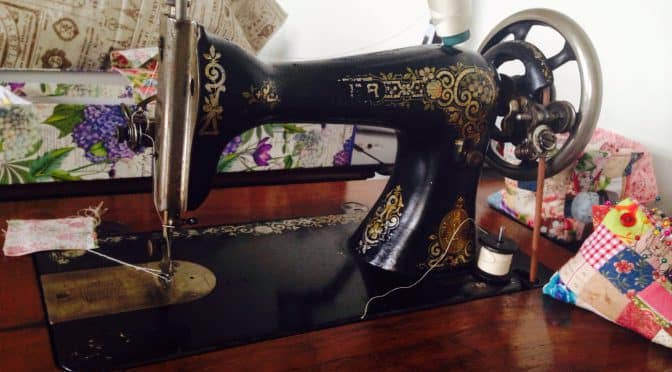Treadle Tinkering
Hello Dear Friends and Readers. Treadle sewing machines are just beautiful.
Some years ago now, my dear husband bought me a treadle machine for my birthday. Of course it came from our favourite store “Mackay’s Mart” on Unley Road. I just loved the look of it. As I have previously described, I think they make the most beautiful occasional tables, even if you are not a sewer.
So it came home and I polished it up the timber exterior a bit, and it sat in the tiny nook of our front hall for a few years, with the top down.

One day, feeling a burst of inspiration (actually this occurred after I had proudly brought another vintage machine to full working order – but that’s another story) I decided to open the lid on the old treadle and see what sort of state it was in. Of course the belt was broken, and a lot of the outside was seized up with rust and dust. So then I wondered “Could I actually get this one to work?”
My mother always says “if you don’t know where to start, start at the beginning” …. Where is that by the way? Cleaning? Seemed a logical place to start. After consulting with Dr Google and drawing from my previous experiences of restorations, I decided to start the cleaning project using lint free cloths and sewing machine oil. With old machines and their lovely surfaces and decals, the last thing you want to do is completely ruin them with harsh modern cleaning products.
This old treadle, is a Singer Class 15 from 1902. If you are lucky enough to have an old Singer, you can date them and find out which machine you have from the http://ismacs.net data base. This is a wonderful resource.
I think it’s not unreasonable to say, that with a machine which is well over 100 years old, and possibly has not been used for the last 20 to 50 years, it’s not going to clean up in one sitting. The thick layers of dust and rust take their toll. I literally gave it a fair soaking in sewing machine oil and rubbed off what was possible. Thereafter I left a rag soaked in the oil on the metal needle plate part of the machine and around the presser foot, as I could not open the sliding needle plate to expose the bobbin. I left it for some days then came back and repeated, cleaned off what was possible, and repeated this process several times within a couple of months. I was now able to open the metal slider of the needle plate to expose the bobbin. The bobbin case was intact with bobbin inside which I was also delighted to find. Its a vertical bobbin and bobbin case and easy enough to insert and remove. I took it out and as expected, found a considerable amount of old thread in the bobbin and bobbin holding mechanism. It may seem obvious, but this is often the first place to start of any machine which is not running well. A lot of old jammed up thread doesn’t help.
Using tweezers and a lot of patience I removed a large amount of lint and thread from the mechanism.
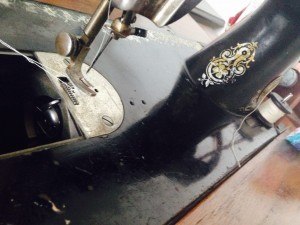
The next thing was to get hold of a new sewing machine belt which I thought may be very difficult, but in the end I got one from the All Make Sewing Centre on Goodwood Road. Fitting the belt was a little more difficult. The belt shouldn’t be too tight. My husband drilled small holes in the ends of the leather to refit the staple. Hammering through with a nail didn’t work. It split the leather. I have since discovered that there is a special tool made for this job. They are called belt pliers.
The remaining challenges were winding the bobbin which turned out to be easy and correct threading. The needle is threaded from left to right on this machine.
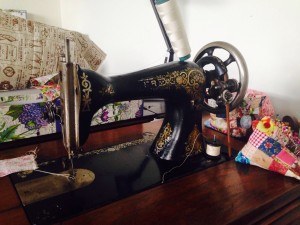
I love using the treadle. It took a while to get the hang of it. The balance wheel must be turned forward in order to make the machine stitch. If it rolls backwards, the thread will snap. It does not sew backwards.
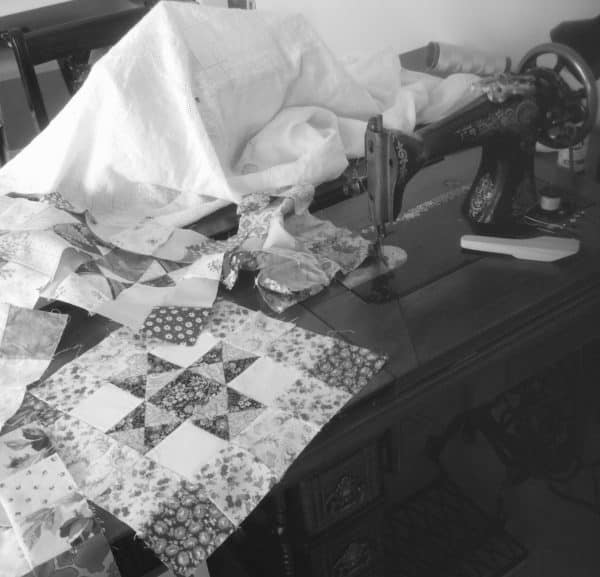
The Treadle pedals are connected to to lovely timber Pitman rod which drives the wheel which is attached to the balance wheel at the top. I know that the Singer 201 was considered the ” Rolls Royce” of sewing machines but…..there is someting absolutely extraordinary about this Singer 15 Treadle. This machine is exceptional. When you consider it was made in 1902, the stitch is and the ease of use extraordinary, and its exceptionally artistically ahead of its time. Even winding the bobbin is a joy and it lasts so long I’ve almost forgotton how to rethread the machine. If you get a chance to own one of these….. Don’t hesitate….
It is lovely to rescue an old sewing machine and table which I thought may only be for its aesthetic appeal and then restore to a fully working machine.
I’m no expert on machines, but I can say that Singer made hundreds of thousands of machines, so it is possible to find replacement parts. It could be very difficult with some more obscure brands.
The experts will take them apart completely but with a bit of patience and machine oil, sometimes an amateur can fix them too, if they are not too far gone!
This machine sews really beautiful straight stitch, and very tiny stitching too if desired. As quilting patchwork is mostly straight sewing it’s ideal.
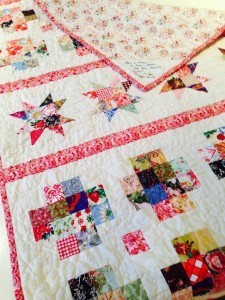
For example this baby quilt, Stars and Crosses Band Quilt was all pieced on this treadle.
Here is a link to the pattern…
If you enjoyed this post you may also like
Happy sewing!

